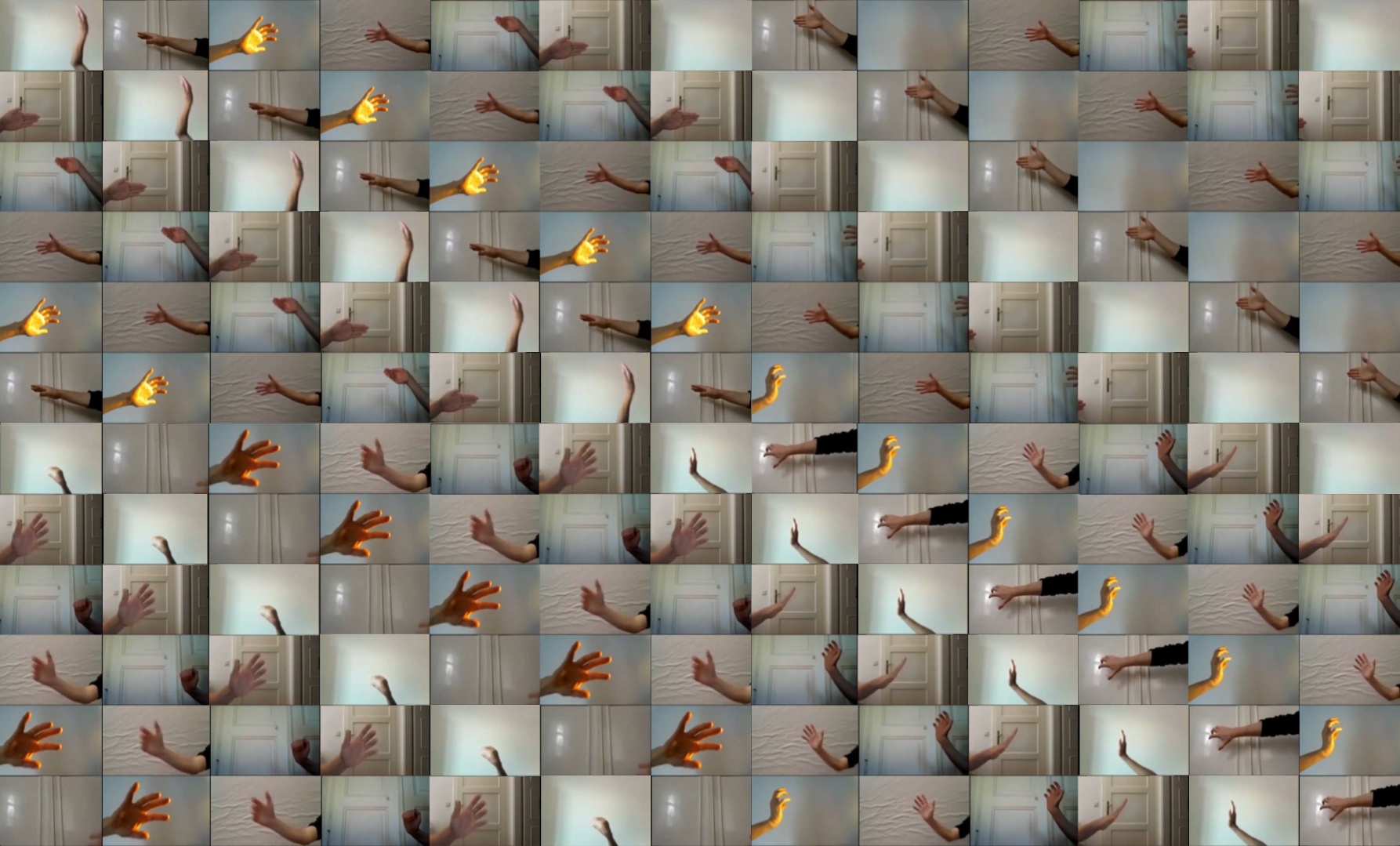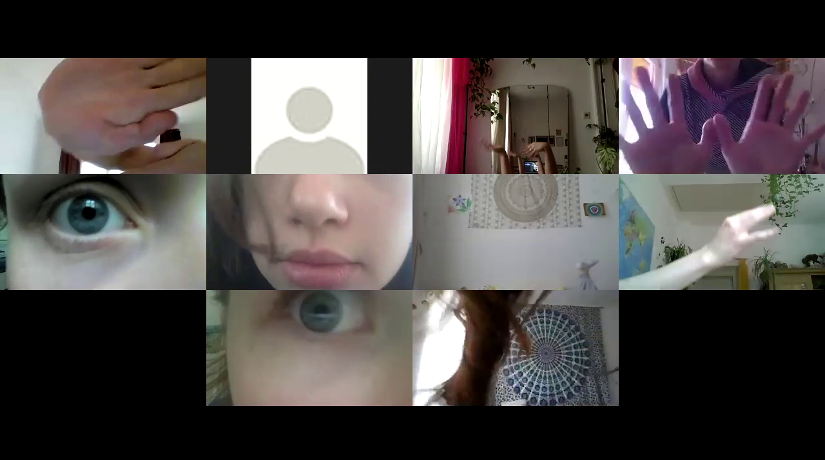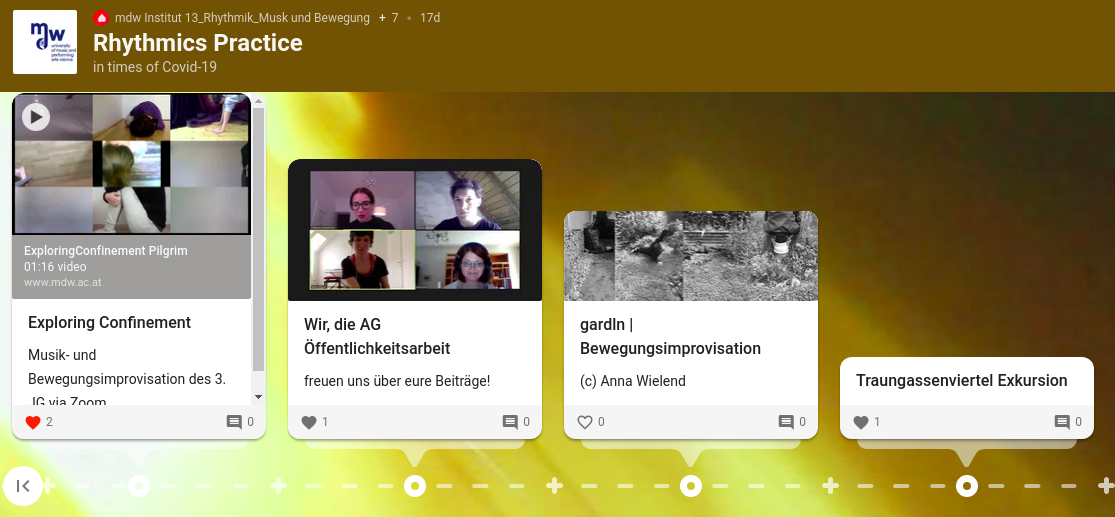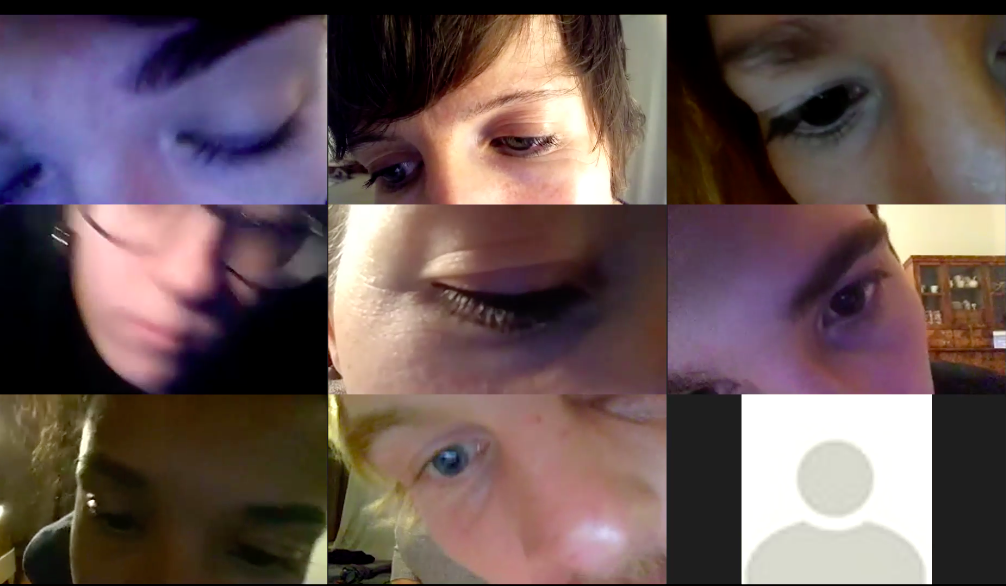The aim of the project Social d[ist]ancing was to develop effective tools and strategies for networked co-creation. Led by Eurythmics professor Hanne Pilgrim and composer Adrián Artacho, the project started in September 2020 with six graduate rhythmics students as participants, dance scholar Mariama Diagne, and the support of the Artistic Research Center (ARC) of the University of Music and Performing Arts Vienna. Structured around six case studies –each featuring a different mode of intermedial transformation–, the project has so far yielded useful insights on the limitations of the medium, while at the same time raising questions about networked artistic practice: In which ways –if any– can ”virtual rehearsals” be thought of as equivalent to traditional (co-located) ones? What is unique about this mode of collaboration that is relevant for artistic practice? In which ways does this circumstance determine the artistic output? and most crucially, how can the limitations of the medium be reframed to add value to the eurhythmics practice?
Since the beginning of the global pandemic, higher education institutions and artists all over the world have embraced distance learning and virtual meetings as more or less provisional solutions. In the case of Rhythmics education, everyday practice had to be adapted overnight – quite the challenge for a discipline based on body work, live music making and social collaboration. Almost one year into this situation, it is time for us to evaluate our experiences in networked rhythmics practice, not as a lesser alternative to a traditional (co-located) one, but as a highly expressive medium in its own right.
Paradoxically, out of the struggle in adapting to the new situation, a particular kind of networked artistic practice have flourished; one that relies on webcams as windows into a shared virtual collaborative space. Today we will present to you the preliminary results of the ongoing artistic research project “Social d[ist]ancing”; in particular, different ways we have explored to articulate that shared virtual space of the videoconference and reframe its limitations as affordances for artistic expression.
Left: dancers of the Dutch National Ballet performing Ballet connects dancers in lockdown. Center: the National Dance Company of Wales performing 2067: Time and Time and Time. Right: Prof. Hanne Pilgrim’s students creating together a piece inspired by Anton Webern’s Six Bagatelles for String Quartet, Op. 9 at the beginning of the COVID 19 pandemic.
Since the first lockdown, teachers of the department of Music&Movement/Rhythmics (MMR) at the University of Music and Performing Arts Vienna navigated the problem of music-related dance practice with their students from an initial asynchronous approach –with individual video assignments– towards a more interactive networked practice using videoconference tools. Together with our students, we created a body of choreomusical work that delves into the idiosyncrasy of the webcam language. Not only does this approach explore the aesthetics of this singular medium, but it is also a transformative process that encourages the participants to re-examine the fundamental conditions for group creativity and artistic collaboration.
We decided to put forth a transdisciplinary research effort to produce useful insights on the limitations of the medium, while at the same time raising questions about networked artistic practice: In which ways –if any– are these ”virtual rehearsals” equivalent to traditional (co-located) ones? What is unique about them instead? In which ways does this circumstance determine the artistic output? Does the concept of ”reconnecting performers across time and space” keep its promise? And perhaps most crucially: how can these limitations be reframed to add value to the rhythmics practice?
The resulting artistic research project started in September 2020 with 9 artists-researchers, and the support of the Artistic Research Center (ARC). Over the course of the case studies, we produced a series of choreomusical works which explore different approaches towards networked artistic collaboration.
One of our first insights was the distorting effect of videoconference in the perceptions of time, space, effort and shape – parameters we routinely use to conceptualise action in rhythmics practice. The perception of one's bodily effort, for example, becomes distorted by the combination of the webcam’s perspective, its orientation and –a subtle yet noticeable– visual delay. This pervasive latency of the system (latency in bodily/corporeal interaction, latency in acoustic feedback and verbal communication) distorts also time perception, which itself affects performer interaction abilities in different ways. Performers can no longer rely on kinaesthetic responses from their collaborators; instead, they need to draw a shared sense of time from the perceived movement on the screen or, alternatively, form symbolic representations of time such progress bars, clocks and countdowns. The perceived flow of social interaction is also heavily influenced by contingencies such as extended waiting times (often attributed to technical mishaps such as unstable network connections, or fixated attention on the computer screen (which itself limits the available bodily positions). The aggregate effect of these factors tends to hinder the flow of interaction, causing frustration and the perception of a slacking workflow. It is also the case, however, that these limitations can be reframed as a means to articulate the shared virtual space differently.
The constraint most noticeable in a videoconference-centered setup is, perhaps, the spatial one. In our practice sessions we first broke down the constraint into relevant components, and then tried to set them side by side with potentially novel affordances each of them creates. A networked rehearsal situation can therefore be thought of, not as a lesser [rehearsal instance], but one of a different kind altogether. What follows are some examples of how we used these new affordances to articulate the shared virtual space –the videoconference in our case– beyond its intrinsic limitations.
When participating in a videoconference, interaction with other performers is strictly restricted to the computer screen, which tends to consume all the performer’s attention. The physical space around the participant is represented in the screen, yet detached from the shared virtual space of the videoconference application. This duplicity between the performed action and its representation (as captured by the webcam) is perceived by the performer as a strange form of visual counterpoint, modulating her subjective experience. Moreover performers are afforded a new virtual space to interact with: the composite image of all video participants in the gallery view. Considering this (inescapable) tiled space in addition to the interaction space –conformed by individual gestures respect to each other–, and the physical space surrounding the performers –the webcam space, if you will–, participants operate in three distinct spaces which they can access playfully in a polyphonic manner.
Example: performers move their faces towards the webcam in order to devise a collective ‘eyebrow-phrase’ in the tiled structure of the gallery. This gesture presupposes a movement of the whole body approaching the camera. The actions in the non-virtual space embedding the performers can be perceived as a contrapuntal third voice; in a given moment, the performers join the video conference with an additional second device (a smartphone), hence rendering their whole body movement –the third voice– visible.
In contrast to physical space, webcam space is bounded, reduced and can sometimes feel a bit fake. Despite the latency-induced strangeness and the disconnect with the surrounding physical environment, the camera also provides interesting new possibilities; for example, visual aspects of any individual performance can be controlled independently from one another. From the perspective of the camera to the light quality; from the choice of a specific background to the use of any number of elements (real or otherwise) as props, the visual language of the webcam provides vast expressive possibilities, particularly when combined with the other webcams as in videoconference-centred rhythmics practice.
One year into the pandemic, we are excited about the expressive possibilities of networked practice waiting to be unearthed, and are already working on the design of new technical applications that address some issues that arose during our working sessions. It is to be expected that more specific applications –together with finer strategies– may help mitigate the frustration over the shortcomings of videoconference as a tool, and eventually enable better remote collaboration. The examples presented in this article are in no way meant to be exhaustive, but to spark a stimulating discussion in the artistic community as to how to move our practice forward beyond the horizon of the COVID-19 crisis.
References
Artacho, Adrián/Medina, Oscar (2021): SoDA - An application kit for networked dance performance, in: Proceedings of the NIME Conference, Vol. 50. https://doi.org/10.21428/92fbeb44.069f7f69






